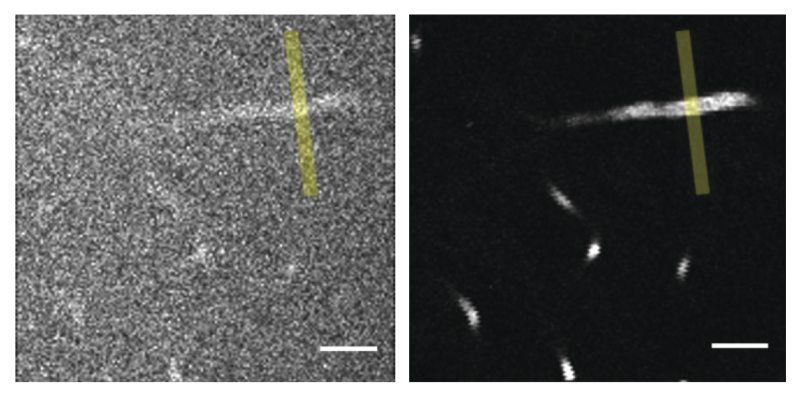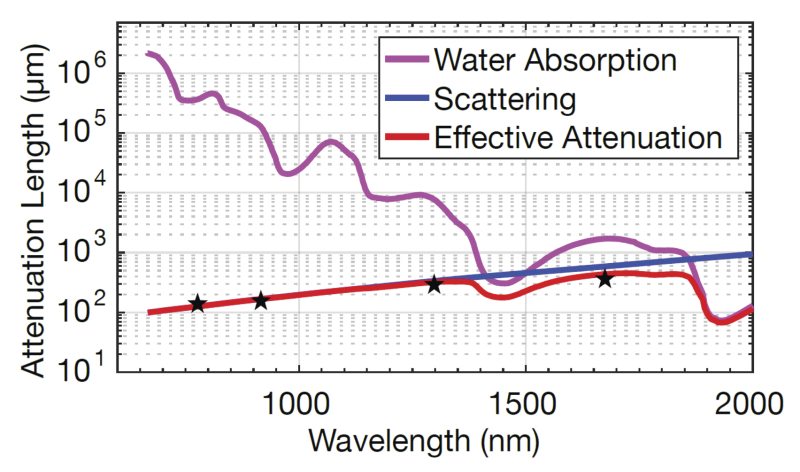Three-Photon Fluorescence Microscopy (3PF)
Three-Photon Fluorescence Microscopy (3PF)
Three-Photon Fluorescence Microscopy
Three-photon fluorescence (3PF) microscopy can provide a significant advantage over 2PF microscopy in strongly scattering samples such as the mouse brain. The fluorescence from three-photon excitation falls off as 1/z4, where z is the distance away from the focal plane, while the fluorescence from two-photon excitation falls off as 1/z2. Thus, three-photon excitation reduces the background from regions away from the focal plane and improves the signal-to-background ratio by orders of magnitude. This reduction in background is illustrated in Figure 1 where 2PF and 3PF are compared.


One remaining challenge is that the cross-section (or the probability of excitation) for 3PF is several orders of magnitude smaller than for 2PF, requiring lasers with much higher peak powers for efficient excitation. However, to prevent damage at the surface of samples, the average power must be limited. Thus, to achieve the required peak powers, laser systems that produce 100 fs pulses with higher energy but with lower repetition rates (to maintain modest average power) are required. A typical laser for 3PF microscopy produces 100 fs pulses every 1 µs (a repetition rate of 1 MHz). Therefore, 1 W of average power gives a peak power of 10 MW with the laser on only 0.00001% of the time. Laser systems that produce ultrashort pulses at this high energy are based on ultrafast amplifier systems that operate at a wavelength of 1 µm. To shift the wavelength to the target wavelengths of 1.3 µm and 1.7 µm, additional nonlinear conversion schemes are required including SHG and OPG.
In THG microscopy, the fluorescent dye is omitted and the third harmonic signal is generated from the sample itself. In a homogenous sample, the THG signal from above the focus cancels the signal generated below the focus due to phase matching. Thus, a third harmonic signal is only generated when the focus is close to a gradient in the refractive index. As a result, THG microscopy is particularly well-suited for 3D label-free imaging of transparent specimens where the membrane or other interface is of interest.
When a combination of techniques is utilized to interrogate a single sample, it is referred to as multi-modal imaging. Using multiple techniques allows investigators to look at different features in the same sample as illustrated in Figure 3, which shows a 3D reconstruction of a mouse brain cerebellum. Fs pulses at 1.3 µm are used to excite the tissue, which generates 3PF in fluorescein-labeled blood vessels while the same wavelength also produces a THG signal in different portions of the cerebellum, i.e., myelinate fibers.

The MKS Spectra-Physics Spirit-NOPA-VISIR is a family of automated non-collinear optical parametric amplifiers (NOPA) specifically built and optimized for the Spectra-Physics Spirit® and Spirit® One™ pump lasers. This combination creates a powerful, user-friendly, tunable, high repetition rate source of ultrashort pulses for in vivo, deep-tissue imaging in neuroscience, spectroscopy, and other ultrafast scientific applications. The Spirit-NOPA-VISIR laser provides an ideal platform for 3PF microscopy as it produces microjoule pulses at both 1.3 µm and 1.7 µm.
Related Topics
Bioimaging